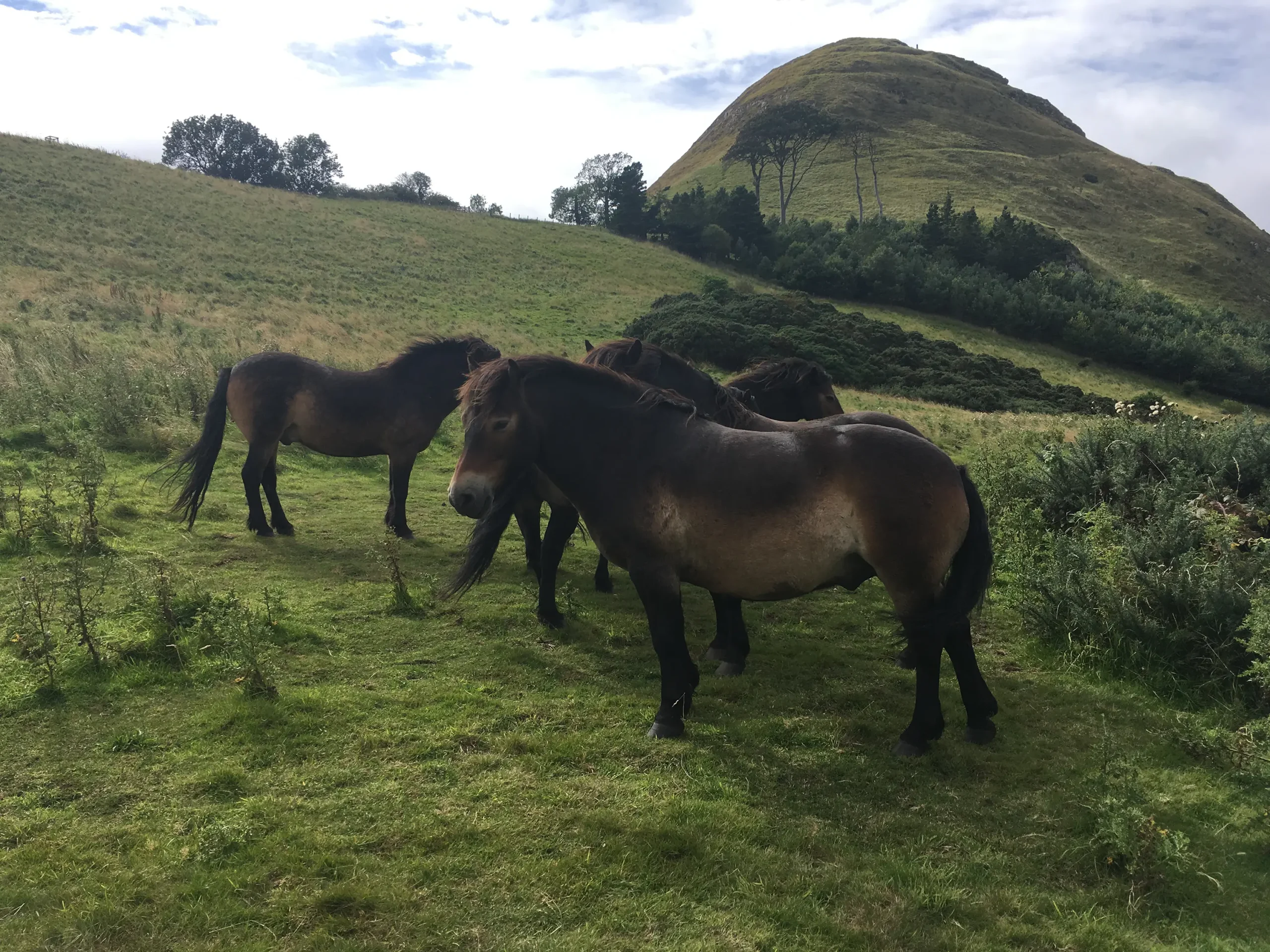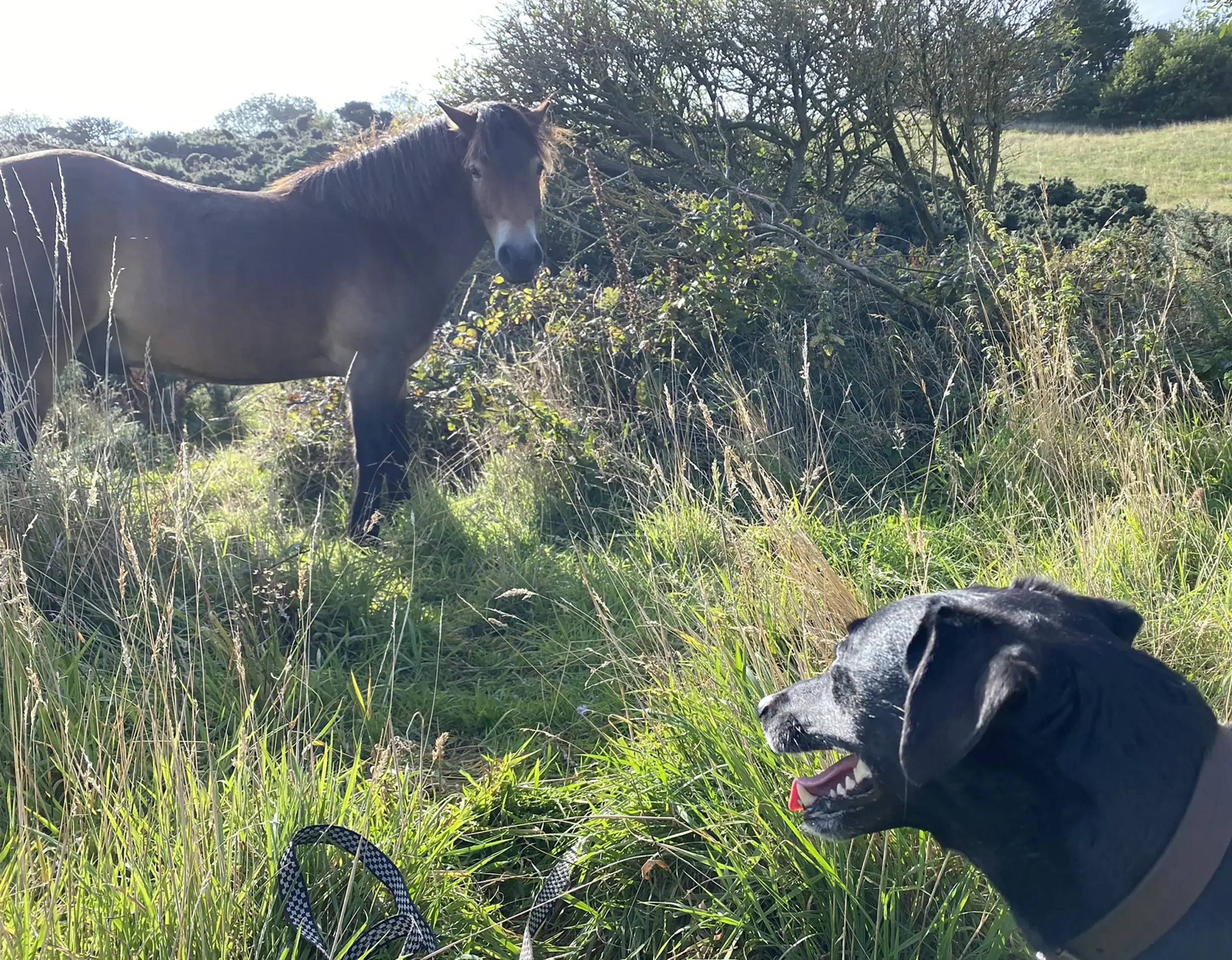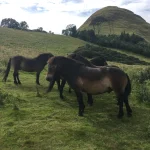
If you take a walk up the North Berwick law, you may be surprised to bump into some unexpected residents. Anyone could be forgiven for thinking that a gang of ponies hasbroken free from a nearby field and taken over the hill but the this is, in fact, their permanent home.
Since 2013 a group of Exmoor ponies have been part of a conservation project to enhance the biodiversity of North Berwicks’sSSSI heritage site. As well as Traprain law further to the south, this project and the site are managed by East Lothian council ranger service and a group of volunteers. Conservation grazing has been historically practiced in this area, but ceased on the Berwick law for a decade creating an opportunity for gorse and rank grasses to expand over the rare and special rocky habitat. There have been a few changes to the herd along the years but the current band is made up of Sherlock, Oberon, Dino, Pluto, Rebel, Artemis, Jack, and Sparrow.
The site is a steep volcanic, conical hill; an unusual geological formation being a Crag and Tail. It is home to species of plant such as Yarrow, Purple milk vetch and Wild Thyme as well as unusual mosses and lichens found on the bare rock areas. To the East of the hill is a grassland field with wet areas and ponds
This method of management, conservation grazing, is not new but is regaining popularity as a sustainable and low impact method of managing sites which are sensitive, or present access issues for machinery. Charities such as the RSPB use conservation grazing successfully on many of their reserves, and due to the requirement for hardy animals for this job, it is a large supporting factor in the preservation of rare native livestock breeds such as Hebridean sheep and Belted Gallaway cattle.
When it comes to species selection, sheep, goats, cattle and horses are the most popular choices. Each one bringing their own set of skills and benefits – choice of grazer is really down to character of the land and what outcome you are looking for;
- Sheep – Sheep are low level grazers, which will maintain grass at a short, uniformed sward. Being browsers, they tend to favour broad leaf plant varieties and flowers. They are light footed and small – which means they will not damage or break up ground as much as other species but they tend to avoid tall and rough areas of vegetation.
- Goats – Goats have similar feeding habits to sheep, but will eat woody material and scrub; they can be an overgrazing risk however and they are notoriously good escape artists, so containing them can be a challenge!
- Cattle – Cattle are all round grazers and will eat their way through larger rougher vegetation. Their grazing style creates holes and bare patches of earth; providing opportunities for seeds to germinate. They are large and heavy so will break up the ground in patches and trample thick vegetation, such as bracken, creating a habitatmosaic and diversifying the overall vegetation structure.
- Horses and ponies – Like sheep – horses and ponies graze close to the ground – but unlike sheep and other ruminants, they graze constantly. What goes in must come out; they typically create latrines which they will not feed in or around. These latrines quickly become areas of high fertility and low disturbance, where rough grasses can grow up – adding areas of cover for birds and further diversification of the habitat overall. They will create gaps in hard vegetation, in a similar way to cattle, but their feet will damage the ground less.

The Exmoor breed was selected to graze North Berwick Law because of their tough and hardy constitution; they are part of an ancient breed, native to the UK andbrought back from near extinctionafter the 2nd world war. Exmoor’shave sturdy feet and can withstand harsh weather due to their double coat, a benefit to them on the hill’ssteep slopes and exposed location.
The ponies feed exclusively on what they forage on the hill, breaking gorse patches and areas of thick grass which could encroach on the bare rock. They have a varied diet of grasses, herbs, shrubs berries and fruits, all found on the Berwick law, with no supplementary feeding needed. The impact they have made to the habitat, in particular gorse cover, has been significant since their arrival in 2013. Theycontinue to carry out the majority of the habitat restoration work themselves, with occasional help from visiting volunteer work groups and a flock of sheep that graze periodically, to keep the grass trim.
Health and welfare are and important topic and the gang are monitored every day by rangers and volunteers. Any issues are address as they arise; in 2020 two of the ponies, Morse and Gadget were moved off of the law due to lameness. After a period of rest, the decision was made not to return them and they were moved to a private estate to live out the rest of their lives on easier ground. Morse and Gadget were replaced by Jack and Sparrow, who integrated into the herd after a bit of initial friction – they are all a happy gang of ponies now though.

North Berwick law is a popular walking location and the ponies are a welcome sight to those who visit. They are unbothered by joggers, on-lead dogs and people climbing to the top of the hill; mostly keeping themselves to themselves. On occasion, however, you might be lucky enough to turn a corner to find one or more of the crew breaking through the scrub. The ponies have free access to the hill, but are confined to the bottom paddock when contract work is being carried out, or the sheep are in for a visit. The instances of conflict with visitors are few and far between, usually being issues with members of the public feeding them, which is strongly discouraged.
The North Berwick Law ponies are a wonderful companion to the site, quietly managing the habitat and adding a real element of charm. They are well worth a visit; they even have their own Facebook page which is updated regularly with photographs, videos and insights into their daily antics, which are fascinating to watch.
If you get a lovely sunny day, you might catch one of them snoozing in the sun, or going for a dip in the pond, before you head into town for a coffee on the beach. I can’t think of a better way to spend a day.
With biodiversity enhancements and ongoing biodiversity maintenance required by NPF4, grazing can be a useful way to establish and maintain biodiverse grassland habitats.
By Georgina Ord.
